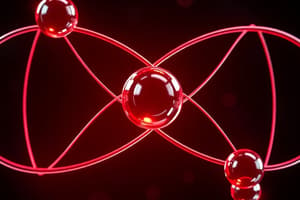Podcast
Questions and Answers
What is the main concept of Molecular Orbital Theory (MOT)?
What is the main concept of Molecular Orbital Theory (MOT)?
- Formation of new atomic orbitals by the overlap of molecular orbitals
- Preservation of individual identity of atomic orbitals after overlap
- Formation of molecular orbitals by the overlap of atomic orbitals (correct)
- Conversion of molecular orbitals into atomic orbitals
What happens to the individual identity of atomic orbitals after overlap in Molecular Orbital Theory?
What happens to the individual identity of atomic orbitals after overlap in Molecular Orbital Theory?
- It becomes more defined
- It transforms into a new type of orbital
- It is completely lost (correct)
- It remains unchanged
How do molecular orbitals form in Molecular Orbital Theory?
How do molecular orbitals form in Molecular Orbital Theory?
- By maintaining a separate existence from atomic orbitals
- By converting into atomic orbitals
- By absorbing electrons from atomic orbitals
- By constructive or destructive overlap of atomic orbitals (correct)
What does the Valence Bond Theory fail to explain, leading to the need for Molecular Orbital Theory?
What does the Valence Bond Theory fail to explain, leading to the need for Molecular Orbital Theory?
Why does Valence Bond Theory fail to explain the color of certain compounds?
Why does Valence Bond Theory fail to explain the color of certain compounds?
Flashcards are hidden until you start studying
Study Notes
Molecular Orbital Theory (MOT)
- Explains the formation of molecules in terms of the molecular orbitals that result from the overlap of atomic orbitals.
Atomic Orbitals and MOT
- After overlap, individual atomic orbitals lose their identity, resulting in a new set of molecular orbitals that are delocalized over the entire molecule.
Formation of Molecular Orbitals
- Molecular orbitals form through the combination of atomic orbitals from individual atoms, resulting in a set of molecular orbitals that are occupied by the molecule's electrons.
Limitations of Valence Bond Theory
- Valence Bond Theory fails to explain the electronic structures of molecules with unpaired electrons and the existence of molecular oxygen and ozone.
- It also fails to explain the presence of multiple bonds between atoms of the same element, such as in O2 and N2.
Color of Certain Compounds
- Valence Bond Theory cannot explain the color of certain compounds, as it only considers the molecular geometry and not the electronic transitions that occur between molecular orbitals, which are responsible for the color of a compound.
Studying That Suits You
Use AI to generate personalized quizzes and flashcards to suit your learning preferences.




